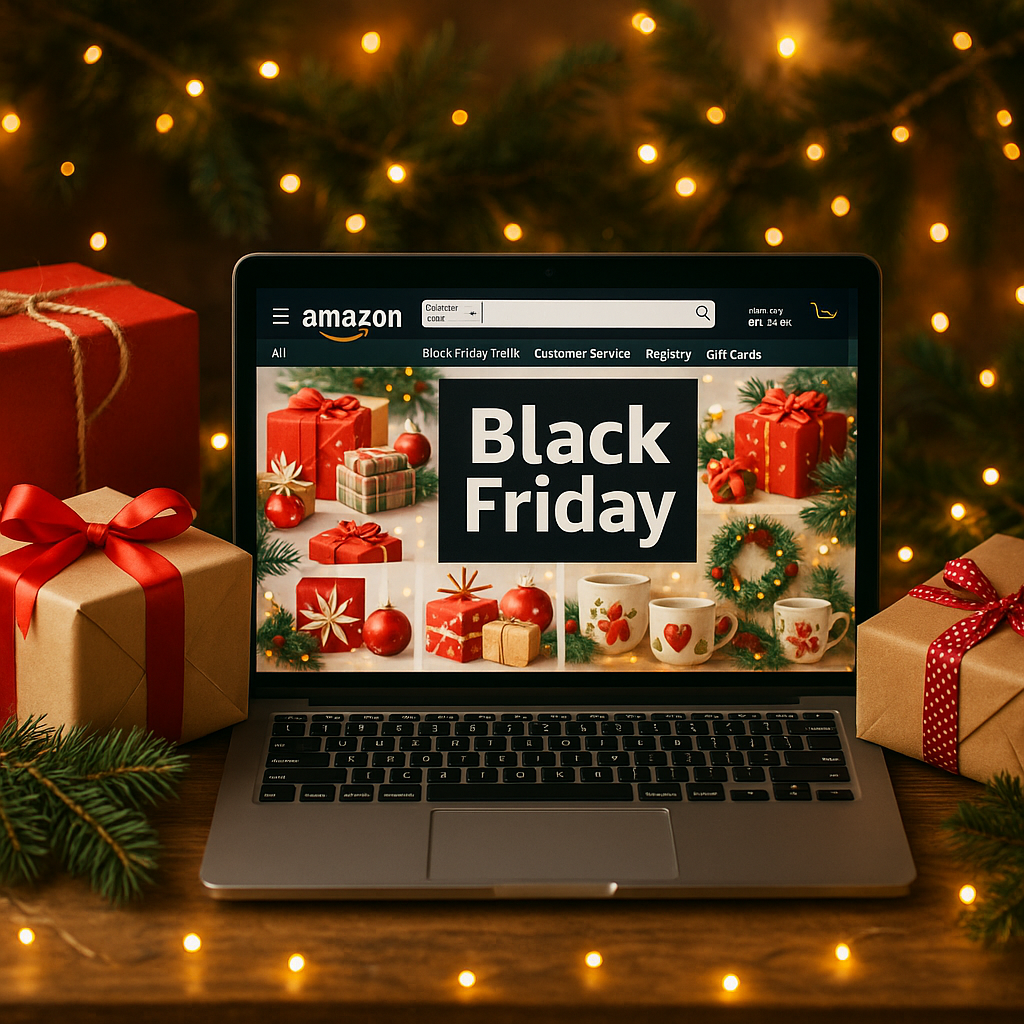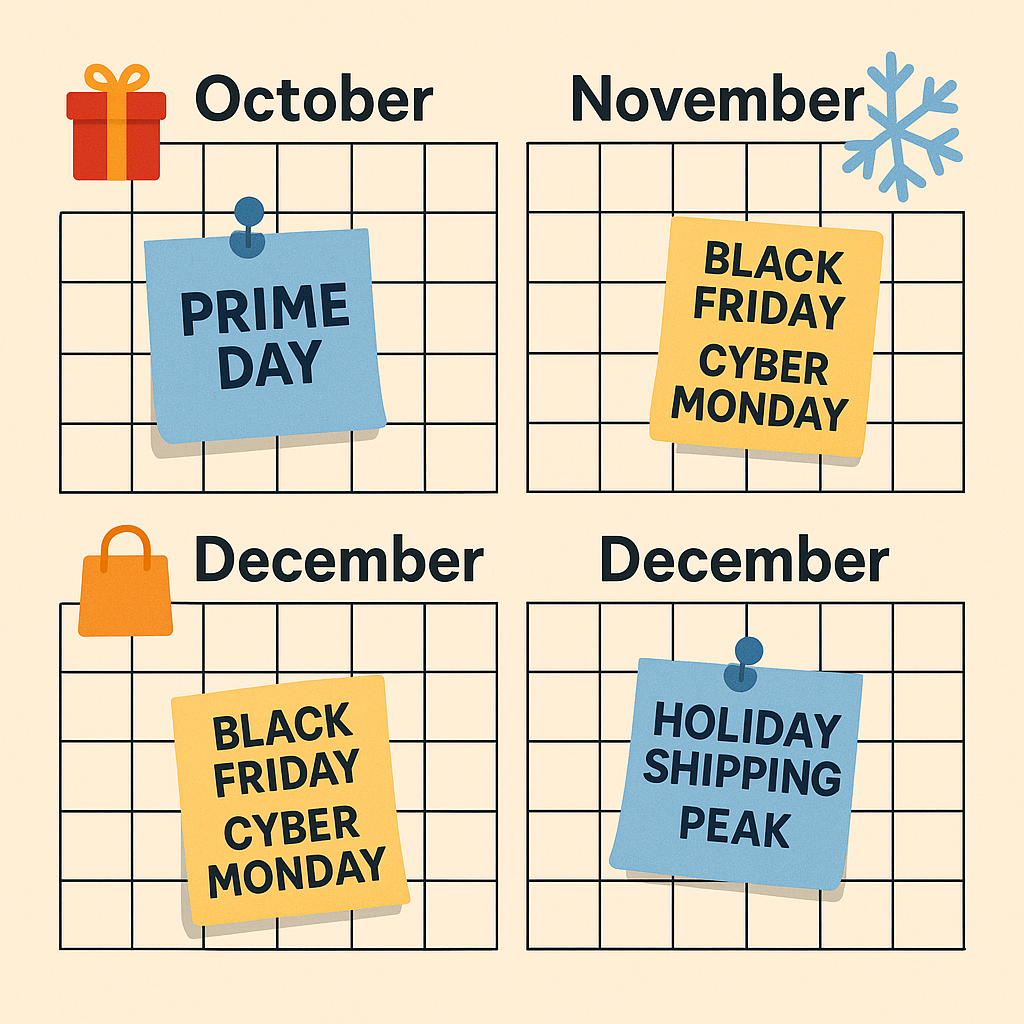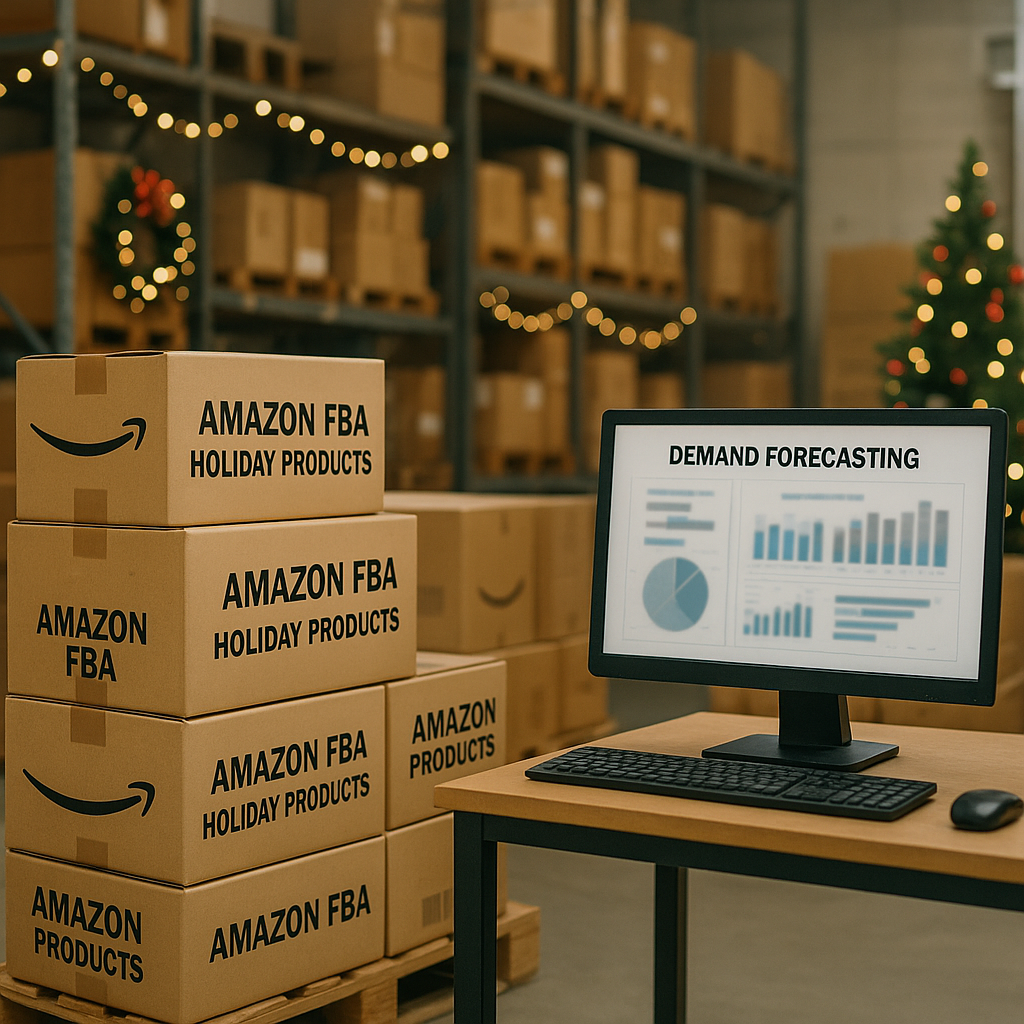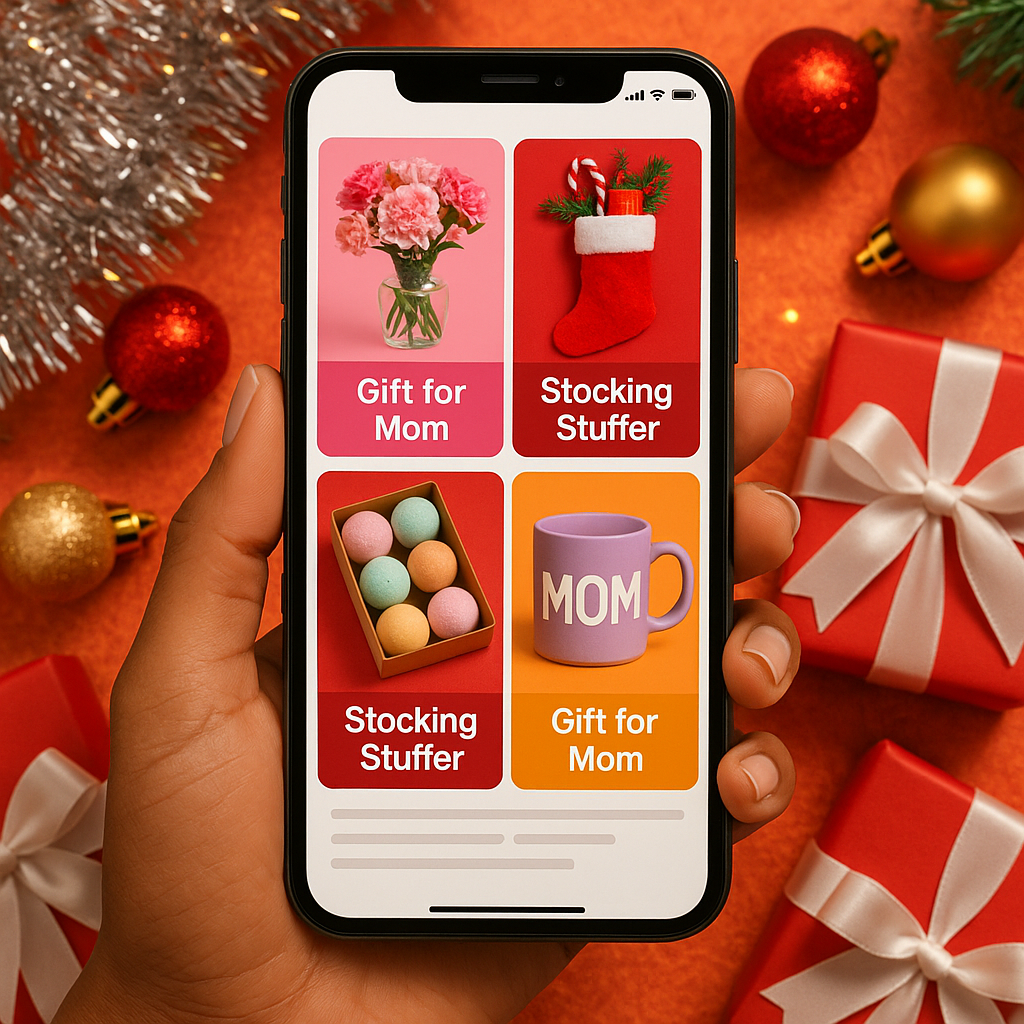Amazon Holiday Sales Strategy: How to Prep for Black Friday & Beyond
The holiday shopping season represents the most lucrative opportunity of the year for Amazon sellers. With Black Friday and Cyber Monday leading into December’s gift-buying frenzy, Q4 can make or break your annual revenue targets.
What distinguishes successful sellers is not luck but strategic preparation—a comprehensive approach encompassing inventory management, marketing tactics, promotional strategies, and operational excellence.
In this guide, you’ll discover how to build a robust Amazon holiday sales strategy that maximizes visibility and conversions during peak shopping periods. From critical timeline planning to post-holiday analysis, we’ll equip you with actionable steps to capitalize on the season’s immense sales potential while avoiding common pitfalls that plague unprepared sellers.
Mapping the holiday sales calendar & key dates
Understanding Amazon’s expanding promotional calendar is essential for effective planning.
The Q4 selling season has evolved beyond just Black Friday and Christmas shopping.
Major events & opportunities
Amazon’s holiday shopping season now features multiple tentpole events that attract different shopper segments:
- Fall Prime Day/Prime Big Deal Days (October) – This relatively new addition serves as an early holiday shopping kickoff
- Black Friday (Day after Thanksgiving) – The traditional retail holiday, now extending to a week-long event
- Cyber Monday – Digital retail’s biggest day, driving massive traffic and conversions
- December holiday shopping peak – Extended buying period with particular intensity in the shipping cutoff week
- Year-end clearance events – Post-Christmas opportunities for inventory liquidation
- January promotional window – Often overlooked opportunity for gift card redemptions
Each event attracts different customer motivations—early-bird shoppers seek deals during Prime events, while last-minute buyers dominate the final shipping days of December. Your strategy should adapt accordingly.
Setting your prep timeline
Working backward from key holiday dates is crucial for adequate preparation:
- 3-4 months before Black Friday: Begin inventory forecasting and purchasing
- 10 weeks before: Review and update all product listings with seasonal keywords
- 8 weeks before: Submit Lightning Deal applications
- 6 weeks before: Ensure inventory arrives at fulfillment centers
- 4 weeks before: Activate early-stage awareness campaigns
- 2 weeks before: Deploy promotional content and finalize all deal structures
- 1 week before: Increase ad budgets and adjust bids
Meeting FBA deadlines is particularly critical. Missing Amazon’s inventory cutoff dates can devastate your holiday strategy, regardless of other preparations. Document key dates as soon as Amazon publishes them, typically by mid-summer.
Strategic inventory & fulfillment planning
Inventory management becomes exponentially more complex during the holiday season, with stock-outs potentially costing you the entire sales boost you’ve worked toward.
Forecasting demand with data
Accurate forecasting requires multiple data inputs:
- Historical performance: Analyze previous holiday sales by product, noting growth patterns
- Seasonal trends: Some products show predictable seasonal spikes
- Market conditions: Consider economic factors influencing consumer spending
- Promotional impact: Factor in the lift from planned promotions and advertising
- Competitive landscape: Evaluate competitor inventory positions and promotional strategies
Begin with your baseline sales data, then build variable forecasts that account for best-case, expected, and worst-case scenarios. Apply growth multipliers to previous holiday data—many products see 3-5x normal volume during peak days.
Navigating FBA storage & deadlines
Amazon’s fulfillment network faces enormous pressure during Q4, resulting in storage limits and deadline enforcement:
- Review your inventory performance index regularly to maximize storage allocations
- Consider NARF (Non-Amazon Replenishment Fulfillment) for overflow inventory
- Implement a hybrid fulfillment approach using FBA for fast-moving items and third-party logistics (3PL) as backup
- Create buffer stock at alternative warehouses that can quickly replenish FBA inventory
- Monitor IPI scores to prevent storage restrictions
Remember that Amazon typically imposes stricter inventory limits during Q4. Plan for this by prioritizing your best-selling items and those with the highest profit margins for precious FBA space.
High-impact listing optimization for the holidays
Consumer search behavior shifts dramatically during the holiday season, requiring strategic adjustments to your product listings.
Keyword research & seasonal SEO
Holiday shoppers use distinct language patterns that differ from year-round searches:
- Gift-oriented terminology: “gifts for,” “present for,” “stocking stuffer”
- Recipient-based searches: “for men,” “for mom,” “for kids”
- Occasion specificity: “Christmas,” “Black Friday deal,” “holiday”
- Urgency indicators: “same-day,” “fast shipping,” “guaranteed delivery”
Conduct seasonal keyword research using Amazon’s autocomplete function, Brand Analytics (if available), and third-party tools. Integrate these terms naturally into titles, bullet points, and backend search terms. Prioritize high-conversion seasonal keywords even if they have slightly lower search volume.
Imagery, A+ content & mobile experience
Visual elements require special attention during the holiday season:
- Update main images to highlight gift-worthiness or seasonal applications
- Create holiday-themed lifestyle shots showing products in festive settings
- Add gift-giving context to secondary images (e.g., gift wrapping, unboxing)
- Optimize A+ content with holiday-specific modules and gift guides
- Ensure all images render properly on mobile devices, where most holiday browsing occurs
Mobile optimization is particularly crucial during the holidays as shoppers browse deals on smartphones while in physical stores or during family gatherings.
Test your listings on multiple devices to ensure a seamless experience.
Promotional tactics: Deals, discounts, & bundles
Strategic promotions drive holiday visibility and conversions, but require careful planning to maximize profitability.
Structuring discounts for Black Friday & Cyber Monday
Different promotional vehicles serve different strategic purposes:
- Lightning Deals: High-visibility opportunities that drive significant traffic
- Coupons: Visual incentives that increase click-through rates
- Percentage discounts: Clear value propositions for comparison shoppers
- Buy One Get One (BOGO): Effective for increasing average order value
- Limited-time offers: Create urgency and immediate action
Structure your promotional calendar to maintain momentum throughout the season. Begin with moderate discounts during early November, intensify for Black Friday and Cyber Monday, then adjust based on inventory levels through December. Consider your margins carefully—the goal is increased profit, not just revenue.
Bundling & “giftability”
Strategic bundling serves multiple purposes during the holiday season:
- Creates unique offerings competitors can’t easily price-match
- Increases perceived value without deep discounting
- Moves slower-selling inventory alongside popular items
- Simplifies gift selection for uncertain shoppers
- Boosts average order value
Emphasize “gift-ready” presentation in your listing content and images. Consider creating holiday-exclusive bundles that solve gift-giving challenges. Virtual bundles can be particularly effective when physical bundling isn’t practical.
Amazon advertising & holiday marketing mastery
The advertising landscape transforms during Q4, with increased competition and changing consumer behavior requiring adaptive strategies.
Sequencing your campaigns
Effective holiday advertising follows a strategic sequence:
- Pre-holiday awareness (4-6 weeks before): Broad targeting to build audience pools
- Early consideration (2-3 weeks before): Retargeting and category-specific campaigns
- Peak conversion (Black Friday through Cyber Monday): Aggressive bidding on high-intent keywords
- Sustained engagement (December): Adjusted targeting based on inventory positions
- Last-minute push (shipping cutoff week): Emphasis on fast delivery
Allocate budgets proportionally to expected sales volume, with the heaviest concentration during peak events. Prepare flexible budgets that can scale quickly for campaigns showing strong performance. Consider dayparting strategies to maximize visibility during peak shopping hours.
Advanced tips—omnichannel, social, influencers
Extend your marketing reach beyond Amazon’s ecosystem:
- Coordinate off-platform advertising to drive traffic to Amazon listings
- Leverage social media to announce limited-time offers and create urgency
- Partner with influencers for holiday gift guides featuring your products
- Utilize Amazon Posts to showcase seasonal applications of your products
- Update Brand Store content with holiday-themed collections and gift guides
Integrate marketing channels for consistent messaging and timing. Create Amazon Attribution links to track off-platform marketing effectiveness. Consider using Amazon DSP for advanced audience targeting if your budget allows.
Customer experience, reviews, & operational excellence
Holiday shoppers have heightened expectations and reduced patience. Meeting these expectations distinguishes successful sellers from the competition.
Capturing & leveraging reviews
Reviews take on special significance during the holiday season:
- Accelerate review generation through post-purchase communication
- Highlight gift-specific aspects in review requests (“How did the recipient like the gift?”)
- Respond promptly to questions and concerns, especially regarding delivery timing
- Feature video reviews that demonstrate product quality and features
- Address negative feedback immediately to prevent snowballing concerns
Monitor review velocity closely during high-volume periods. New shoppers rely heavily on recent reviews when making purchase decisions. Consider tools that automate review requests while complying with Amazon’s policies.
Customer service responsiveness becomes particularly critical during the holiday rush. Scale up support capacity or hours to handle increased inquiries. Create templates for common holiday-specific questions to enable rapid responses. Monitor buyer messages multiple times daily, as timely responses directly impact customer satisfaction metrics.
Measuring success & adapting for next season
Systematic analysis of holiday performance provides insights for continuous improvement and future planning.
Establish comprehensive performance tracking that captures multidimensional metrics:
- Sales metrics: Total revenue, units sold, average order value, sales by promotion type
- Advertising metrics: ACOS, TACOS, impression share, conversion rates by campaign
- Inventory metrics: Stock turnover rate, stockout frequency, holding costs
- Customer metrics: Review rate, star rating, customer questions, support tickets
- Profitability metrics: Margin by SKU, promotion efficiency, advertising ROI
Compare performance against both previous holiday seasons and your forecasts. Document successes and failures systematically. Create a detailed post-season analysis to inform next year’s strategy. Begin planning for the next holiday season immediately after the current one concludes, while insights remain fresh.
Conduct competitor analysis to identify marketplace trends. Which competing products gained or lost market share? What promotional tactics seemed most effective? Use Amazon’s Brand Analytics (if available) to track search term performance and conversion rates.
Conclusion
A successful Amazon holiday sales strategy requires comprehensive preparation across multiple business dimensions. Begin with thorough market and inventory planning, optimize listings for seasonal search behavior, implement strategic promotions and advertising, and maintain operational excellence throughout the peak season.
The most successful sellers approach the holiday season with both detailed planning and flexibility to adapt as market conditions evolve. By implementing the strategies outlined in this guide, you’ll position your business to capitalize on the enormous opportunity the holiday shopping season presents while building capabilities that benefit your Amazon business year-round.
Frequently asked questions
When should I start preparing my Amazon business for Black Friday and holiday sales?
Begin prepping 3–4 months ahead, with inventory arriving at FBA centers 4–6 weeks before Black Friday. Early seasonal listing and advertising updates give time for Amazon to index changes.
What are the must-have promotions for Amazon Black Friday and Cyber Monday?
Lightning Deals, event-specific discounts/bundles, and time-limited coupons are proven to drive traffic. Aim for competitive pricing (up to 40–50% off on lead items), but watch profitability.
How do I avoid running out of stock during the holidays on Amazon?
Use historic sales data, build in inventory buffers, and monitor FBA constraints. Be ready with backup fulfillment (e.g., Merchant Fulfilled/3PL) in case of FBA shortages.
How can I optimize my product listings to maximize holiday visibility and conversion?
Use relevant seasonal keywords, update images/A+ Content to reflect holiday gifting, and ensure listings are clear and mobile-friendly.
How do I measure the success of my Amazon holiday sales strategy?
Track KPIs like sales volume, conversion rates, ad ROI, and review sentiment; compare to both last year’s holiday figures and your pre-holiday baselines to guide post-season adjustments.
